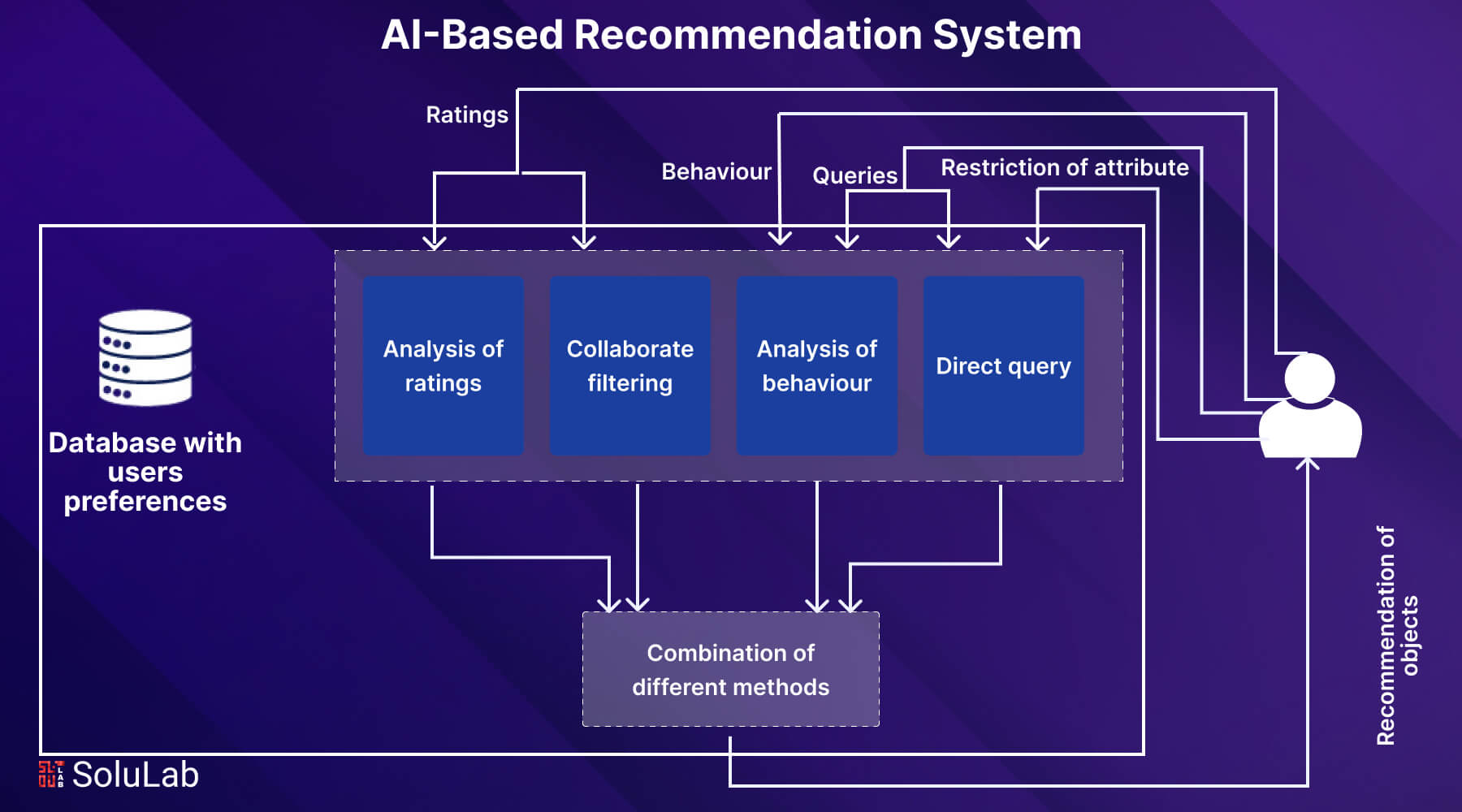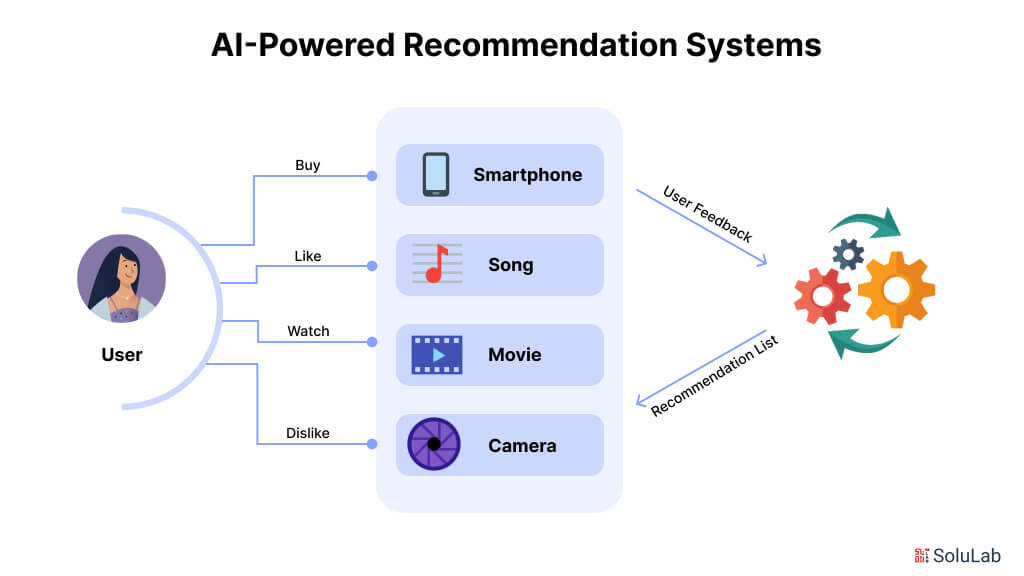
Have you ever wondered how TikTok can suggest videos published only minutes ago? Or how can YouTube detect your newfound interest after seeing only one video about it? Or how does Amazon propose things based on what’s in your buying cart?
The solution is AI-powered recommendation systems (recommender systems or recsys). These systems may provide suggestions to customers according to real-time contextual data, such as the most recent item catalog, user actions, and session context. As per recent statistics, with a valuation of $3.92B in 2023, the worldwide recommendation engine market is expected to expand from 2024 to 2030 at a CAGR (compound annual growth rate) of 36.3%.
If you want to create an AI-powered recommendation system or improve your current system, this blog article is for you. In it, we will provide an introduction to AI-based recommendation systems, discuss the various ways to construct distinct subcomponents, and offer some advice to help you cut costs, manage complexity, and empower your team to ship ideas.
What is an AI Recommendation System?
An AI-powered recommendation system consists of an artificially intelligent system that businesses use to recommend goods, services, or information to consumers based on their interests.
Consider a virtual assistant that learns what you enjoy based on your previous purchases and the preferences of people who share your interests. This is the fundamental notion behind clever recommender systems.
Recommendation engines utilize complex algorithms and statistical models to anticipate and display things, services, or information that are relevant to the user’s preferences. Such technologies are good examples of how artificial intelligence (AI) will be used to promote marketing and user engagement in 2025.

Recent Statistics on Recommendation Systems
Though you may not have given it much consideration, you deal with smart recommendation algorithms essentially all the time whether you purchase online, watch movies on a streaming site, or explore TikTok.
- Originally estimated at USD 2.12 billion in 2020, the recommendation engine market is predicted to reach USD 15.13 billion by 2026 and show a CAGR of 37.46% over the period of 2021–2026.
- About 71% of e-commerce websites provide product suggestions.
- Salesforce research indicates that consumers who click on suggestions are 4.5x inclined to add these products to their basket and 4.5x more likely to finish the transaction.
- Customers who interacted with a suggested product had a 70% greater conversion rate during that session, according to Monetate.
Types of AI-powered Recommendation Systems
Personalized recommendations can be generated using a variety of methods, which are contingent upon the data type and the method used to process it.
AI-powered recommendation systems personalize suggestions based on user preferences and behaviors. Here are the key types with examples:
1. Content-Based Recommendation Systems
Suggests items similar to what a user has previously liked by analyzing item features.
Example: Recommending The Alchemist after reading Life of Pi due to its philosophical themes.
2. Collaborative Filtering Recommendation Systems
Suggests items based on what similar users have enjoyed.
Example: Suggesting Breaking Bad to a user who watched Money Heist, based on other users’ viewing patterns.
3. Hybrid Recommendation Systems
Combines content-based and collaborative filtering for more accurate recommendations.
Example: Suggesting Atomic Habits to a user who reads self-help books and whose peers enjoyed the title.
4. Knowledge-Based Recommendation Systems
Suggests items based on user preferences and needs.
Example: Recommending The Martian for someone searching for science fiction novels with space exploration themes.

5. Deep Learning-Based Recommendation Systems
Uses neural networks to predict user preferences based on complex behavior patterns.
Example: Spotify suggests a custom playlist with both trending and lesser-known songs based on listening history.
These systems enhance user experiences by delivering personalized and relevant recommendations.
Matrix Factorization for Recommendations
Matrix factorization (MF) approaches are the foundation of several prominent algorithms, such as word embedding and topic modeling, and have emerged as a prevailing paradigm in collaborative-filtering-based recommendation systems. Matrix factorization may be used to compute the similarity in user ratings or interactions to generate suggestions. In the basic user-item matrix shown below, Ted and Carol have a preference for movies B and C. Bob like film B. Matrix factorization suggests that because people who appreciated movie B also favored movie C, the latter is a viable suggestion for Bob.
Matrix factorization via the alternative least squares (ALS) algorithm matches the sparse user-item rating matrix of dimensions u-by-i as the product of two dense matrices: the client and item factor matrices, sized u × f and f × i, respectively, where u represents the number of users, i denotes the number of items, and f indicates the number of latent features. The factor matrices denote latent or concealed properties that the algorithm attempts to uncover. One matrix aims to represent the latent or concealed attributes of each user, while the other seeks to depict the latent characteristics of each movie. The ALS algorithm progressively learns numeric “factors” that characterize each person and each object. In each iteration, the algorithm alternately stabilizes one component matrix while optimizing the other, continuing this approach until convergence is achieved.

Why do Recommendation Systems Run Better with GPUs?
Recommendation systems require processing large datasets and running complex machine-learning algorithms to deliver personalized suggestions. GPUs (Graphics Processing Units) play a crucial role in accelerating this process, making recommendations faster and more accurate.
-
Parallel Processing Power
GPUs are designed to handle thousands of computations simultaneously, unlike CPUs that process tasks sequentially. This parallelism helps quickly process massive datasets and speed up tasks like user behavior analysis and model training.
-
Efficient Deep Learning Models
Modern recommendation systems use deep learning techniques like neural networks and matrix factorization. These models involve heavy mathematical computations, which GPUs handle far more efficiently than CPUs.
-
Faster Training and Inference
Training recommendation models on large user-item datasets can take hours or days on CPUs. GPUs significantly reduce this time, enabling quicker model updates and faster real-time recommendations.
-
Scalability
GPUs allow recommendation systems to scale effortlessly by distributing the workload across multiple GPUs, making them ideal for platforms with millions of users.
-
Improved Personalization
With faster data processing, GPUs help systems generate more dynamic and real-time personalized suggestions, enhancing user experience.
Example: Streaming platforms like Netflix and e-commerce giants like Amazon leverage GPUs to deliver instant, personalized content and product recommendations.
By utilizing GPUs, recommendation systems become faster, more scalable, and capable of delivering highly accurate suggestions, improving both user satisfaction and business outcomes.
The Working of a Recommendation System
Interested in the inner operations of recommender systems? This part offers a detailed walk-through analysis of this amazing process.
From the first data collection to the last presentation of recommendations, you will see how these algorithms deftly examine data and translate it into individualized item recommendations.
Phase 1: Information Gathering
The engine gathers a broad spectrum of data during this first phase involving user interactions (such as clicks, views, or sales), user demographics (such as age and location), and thorough item information (such as descriptions and categories). This stage presents a difficulty sometimes referred to as the “cold start problem,” because limited data about new customers or products makes it challenging to first offer correct suggestions.
AI recommendation engine gathers thorough information using several techniques in the data collecting stage.
Web crawlers—automated programs that traverse the Internet gathering data from different Web sites—are one of the main techniques employed. For compiling comprehensive data on things like consumer reviews, product descriptions, and ratings, they are very helpful.
Furthermore gathered is user information via methods like cookie use. Little files are kept on consumers’ devices, cookies monitor visits to and responses to websites. This enables the recommendation system to track behaviors including clicks, views, and purchases thus understanding user behavior on the site. These techniques taken together offer a vast data set from which to create reliable and customized suggestions.
Recommendation systems gather these kinds of data:
- User Behavior Data: It covers the activities users take—that is, the objects they browse, buy, or mark for inclusion on their wish list. It also logs the amount of each of these activities as well as the time spent on every item.
- User Demographic Data: This is personal information about the user including age, gender, location, potential financial status, or educational background.
- Item Data: This includes specifics about the goods or materials that could be recommended, such as descriptions, classifications, price, brand, product specs, genre, and author for books.
- Contextual Data: These are the details on the setting in which user interactions occur—such as the exact moment of day, season, or whether the contact occurred on a desktop or a mobile device.
- Feedback Data: These are customer ratings, reviews, and preferences clearly expressed by the consumers. More directly, this information assists one to grasp the preferences and level of pleasure of the user.
Phase 2: Data Processing
Data processing, a vital phase in which the gathered data is polished and ready for analysis, comes second in the operation of a recommendation engine.
This phase mostly aims to guarantee the data’s usefulness and quality.
Data cleaning first removes erroneous, incomplete, or pointless information. To guarantee that the surviving data is precise and dependable, this might include data discrepancies corrections or noise filters.
Data transformation then turns the unorganized raw data into a structured format fit for study.
Creating human or object profiles, organizing unstructured data (text or pictures), and scaling data to a specified range can all help to normalize data.
Data integration—where data from many sources is aggregated to get a complete view—is another important component. One may combine consumers’ demographic information with their activity, for instance. At last, feature extraction—that is, the identification and extraction of particular traits or “features”—from the data—is very vital.
The recommendation algorithms will then utilize these characteristics—such as the frequency of item views or the kinds of items seen—to create predictions.
Data processing turns unstructured, raw data into a neat, orderly shape necessary for the recommendation engine to operate as it should.
Phase 3: Filtering
By now techniques like matrix factorization are applied.
A method of mathematical prediction of customer preferences is matrix factorization. It breaks down a big user-item interaction matrix into smaller, more reasonable matrices representing people and objects. Then latent elements influencing user preferences are found using these matrices.
Applying certain mathematical recommendation algorithms allows the system to forecast, even in cases of non-user interaction, the likelihood of a user preferring an item.
Phase 4: Formulating Suggestions
Generating suggestions is the fourth stage in the functioning of a recommendation engine; this vital phase in which the processed data and the insights acquired from the previous processes are utilized to offer pertinent objects or content to the user.
At this level, the engine uses algorithms to match user preferences with current products thereby offering individualized and pertinent recommendations.
To create these suggestions the engine takes into account historical user behavior, item similarity, and user profiles.
Using these suggestions, the engine aims to strike a balance between relevance, user involvement, and corporate objectives—such as boosting sales in particular categories or endorsing new products—using which relevance is balanced.
Improving the user experience using timely and pertinent recommendations catered to the requirements and interests of the user is the main aim.
Which are these kinds?
Let’s examine how some e-commerce sites handle their recommendations:
- Customized Recommendations: Based on goods the user has past engaged with, these recommendations—which are based on preferences and prior behavior—show comparable or complimentary products.
- Best Sellers: Popular across the network, best sellers are typically advised to new users or those with minimal contact experience. They show in a certain category what is most bought or trending.
- Related Items: These things are often considered as “Customers who viewed this also viewed,” these recommendations are based on the correlation between goods and proposed items that other users have looked at or bought in connection to the present item.
- New Arrivals: Recommendations emphasizing the newest products or information in a category will help returning consumers find the most recent offerings.
How to Build an AI Recommendation System?
Developing a successful AI recommendation engine doesn’t have to be difficult. Businesses may get from raw data to very precise forecasts by using an organized process. However, there are important factors that are often overlooked. By taking care of issues early on, the procedure and the outcome may be greatly enhanced.
To create an AI-powered recommendation engine for enterprises that meets business goals and provides accurate suggestions, this section lists six essential processes.
Step 1: Establish Business Objectives
Clearly defining the business issue that an AI recommendation engine is intended to address is the first and most important stage in the development process. To establish goals, business and technical teams—including marketing, operations, and product managers—must work together.
Important things to think about:
- What is the primary goal? Should the system optimize content distribution, increase engagement, decrease browsing time, or increase sales?
- Is a recommendation engine driven by AI required? Static content discovery techniques (e.g., staff selections or trending items) may sometimes be enough, despite the potential power of these systems.
- Where will the suggestions appear? Will they show up throughout surfing, on homepages, or after purchases? Should distinct models be used for various platform sections?
- What information is at hand? Are the majority of users anonymous or logged in? While anonymous users need different strategies, logged-in users provide more data.
- Are there limitations imposed by business? Should recommendations give preference to certain goods or content?
- What criteria will be used to establish user similarities? What criteria will be used to identify comparable users if the system employs collaborative filtering?
Step 2: Gather and Arrange Information
Large volumes of data are necessary for an AI-powered recommendation system to function well. Generally speaking, forecasts become better with more data. However, working with new or anonymous individuals presents difficulties. External data sources or generic datasets (such as browsing behavior or demographics) may be helpful in these situations.
There are two main methods for gathering data:
- Explicit Feedback: User-provided information like reviews, ratings, and grievances.
- Implicit Feedback: Information gleaned from user activity, such as past purchases, page views, or social media engagement.
Given that each has advantages and disadvantages, the majority of the top AI-powered recommendation systems combine the two. Customers only judge what they already know, thus explicit feedback is restricted even when it sends obvious signals. Although implicit feedback reveals hidden preferences, it must be interpreted carefully. For instance, a person does not always enjoy a product simply because they see its website.
Step 3: Improve and Process Data
Recognizing shifting user preferences over time is crucial when dealing with data for an implementation of an AI recommendation system Python.
Top techniques for data refinement:
- Give current interactions precedence over out-of-date preferences.
- Older information that no longer accurately represents user interests should be removed or down-weighted.
- Recommendation datasets often include a large number of empty values, which complicates grouping and pattern recognition.
- Python offers strong tools for cleaning, transforming, and preparing data for an AI-powered recommendation system, such as pandas, NumPy, and sci-kit-learn.
Step 4: Create and Sort Suggestions
By using user data to rate goods, a simple AI recommendation engine may now be developed. Simple ranking may provide helpful suggestions even in the absence of machine learning. However, machine learning approaches increase accuracy for increasingly complex systems.
Techniques to improve ranking:
- Hybrid Recommendations: Hybrid AI provides better recommendations, and combines content-based techniques with collaborative filtering.
- Multiple Model Strategies: Using many algorithms for various scenarios and dynamically choosing the optimal one is known as multiple model strategies.
- Machine Learning Integration: Using deep learning, reinforcement learning, or logistic regression to improve suggestions.
Certain portions of a website may benefit from various strategies; for example, homepage suggestions can highlight well-liked material, but post-interaction recommendations might be quite customized.
Step 5: Get Insights by Visualizing Data
To better understand user behavior and enhance recommendation algorithms, visualization is essential.
Data visualization applications include:
- During Data Evaluation: Assists in identifying patterns and irregularities in user interactions during data exploration.
- For Business Decisions: Offers information on user preferences, engagement trends, and content performance.
Large datasets may be difficult to handle, but good visualizations help decision-makers understand and act upon complicated data.
Step 6: Implement the Model and Keep Improving It
Only when a recommendation engine is actively enhancing business results is it worthwhile. It has to be regularly tested, observed, and improved after deployment.
Techniques for optimization:
- Frequent Performance Evaluations: Examine important indicators including engagement, conversion rates, and click-through rates.
- Extend the Sources of Data: Over time, enhance suggestions by incorporating fresh datasets.
- Adjust to Shifting Patterns: Make sure the model adapts to changing user choices.
Stasis is a major concern in recommendation systems; if the model doesn’t adapt over time, its efficacy will deteriorate. By putting feedback loops in place, the system can be continuously improved and kept effective and relevant.
Benefits of Integrating AI-Powered Recommendation System
What impact would an AI-powered recommendation system have on your business? Let’s go over each of the primary benefits of incorporating personalized recommendations.
-
Increased Sales
Primarily, recommendation engines boost revenue by recommending relevant goods or services to customers.
These methods raise the possibility of a sale by showcasing products that consumers are more likely to find appealing. Customers may discover more things that satisfy their requirements or wants as a result of this customized approach, which might raise the average order value.
According to the Epsilon research study, 80% of customers favor companies that provide individualized experiences, demonstrating the importance of customization in determining consumer preferences. This implies that for businesses looking to boost client happiness and loyalty, customization may be a huge competitive advantage.
-
Improved Customer Experience
By making it simpler for users to locate goods or information that aligns with their interests, personalized suggestions improve the user experience.
Customers are more satisfied and loyal as a result of this personalized touch, which enhances the browsing experience.
-
Higher User Engagement
Recommendation engines promote longer and more frequent engagements with the platform by showing users products that align with their interests and preferences.
More time spent on the website, more pages read, and a greater chance of repeat visits may result from this enhanced engagement.
-
Effective Discovery of Products
It might be daunting for consumers to sort through a large selection of goods or materials.
Ask yourself why e-commerce sites sometimes have high bounce rates and abandoned carts while they provide tens of categories, thousands of goods to pick from, and many personalization choices. This is often the result of consumers’ inability to effectively browse your website.
By screening and recommending products based on the user’s preferences, recommendation engines facilitate effective discovery by streamlining the search process and enhancing discoverability.
-
Data-Driven Insights
These search engines provide insightful information on the tastes and behavior of customers. Businesses may better understand their audience by evaluating the data they have gathered. This knowledge can then be used to guide product development, inventory management, and marketing tactics.
-
Better Customer Retention
Customized suggestions can provide a more fulfilling user experience, which may increase client loyalty. Customers are more inclined to come back and keep using a platform if they believe it recognizes their preferences.
-
Optimized Inventory Management
Recommendation engines may help forecast demand for certain items by examining trends and preferences. By ensuring that popular goods are adequately supplied and less popular things are not overordered, this knowledge enables more efficient inventory management.
AI-Powered Recommendation System Examples
By offering customized information, improving user involvement, and driving corporate expansion, AI-powered recommendation systems have revolutionized several sectors. From entertainment and e-commerce to healthcare and banking, these systems examine enormous volumes of data to provide very relevant recommendations. These are some of the most well-known artificial intelligence-powered recommendation systems from several fields below.
- Netflix- Personalized TV Show and Movie Recommendations: Netflix is led in using artificial intelligence for content suggestions. To examine watching history, watch time, interactions—such as stops and rewinds—and user evaluations, the platform employs collaborative filtering and deep learning models. It then recommends material depending on a user’s tastes and viewing patterns, therefore guaranteeing more interaction and retention.
- Amazon- AI-Driven Product Suggestions: One of the most sophisticated AI in the e-commerce industry recommendation engines available is found at Amazon. It suggests items depending on browsing history, prior purchases, and consumer behavior using a mix of collaborative filtering, content-based filtering, and deep learning. Conversion rates are much raised by features such as “Customers who bought this also bought” and “Suggested for you”.
- Spotify- Discovery and Curating of Music: The AI-powered recommendation algorithm of Spotify customizes playlists including Daily Mix and Discover Weekly. The software analyzes song lyrics using natural language processing (NLP), compares user listening behavior using collaborative filtering, and classifies songs depending on pace, mood, and genre using audio analysis. This yields rather customized song recommendations.
- YouTube- Video Recommendation Algorithm: Based on viewing history, likes, comments, and interaction data, YouTube’s AI recommendation engine generates video suggestions. Using deep learning models, the platform forecasts user interests and rates videos, therefore maximizing content discovery for both new and returning users.
- TikTok- AI-Driven Content Feed: Powered by an AI algorithm that customizes video streams depending on user interactions, watch duration, and engagement levels, TikTok’s For You Page (FYP) explains most of its success. To guarantee highly tailored suggestions, it analyzes video footage using machine vision and NLP to decipher hashtags and subtitles.
- LinkedIn- Job and Connection Suggestions Driven by AI: Using machine learning techniques to analyze a user’s profile, industry, talents, and network, LinkedIn’s recommendation system proposes jobs, courses, and professional contacts. LinkedIn gets better over time by always learning from user interactions.
Use Cases of AI-Powered Recommendation Systems
AI-powered recommendation systems are transforming various industries by providing personalized experiences, improving customer engagement, and optimizing business operations. These systems leverage machine learning, deep learning, and data analytics to predict user preferences and deliver relevant suggestions. Below are some of the most impactful use cases of AI-powered recommendation systems across different sectors.
1. E-Commerce – Personalized Product Recommendations
Online retailers like Amazon, eBay, and Shopify use AI-driven recommendation systems to suggest products based on user behavior, purchase history, and browsing patterns. These recommendations appear in:
- “Customers who bought this also bought” sections
- Personalized homepages
- Cart and checkout pages for upselling and cross-selling
2. Entertainment & Media – Content Personalization
Streaming platforms like Netflix, Hulu, YouTube, and Spotify rely on AI to suggest movies, TV shows, and music tailored to user preferences. AI analyzes:
- Watch history and engagement metrics
- Viewing time and frequency
- Similar user preferences to improve recommendations
3. Social Media – Engagement Optimization
Platforms like Facebook, Instagram, TikTok, and Twitter (X) use AI in social media recommendation engines to enhance user engagement by:
- Suggesting relevant posts, videos, and trends
- Recommending new friends, pages, or influencers to follow
- Curating news feeds and personalized content based on user interactions
4. Online Learning – Course and Content Recommendations
E-learning platforms such as Coursera, Udemy, and LinkedIn Learning use AI to recommend:
- Courses based on career goals and past enrollments
- Learning paths customized for skill development
- Study materials and quizzes based on user progress
5. Healthcare – AI-Driven Medical Recommendations
AI-powered recommendation systems assist in diagnosis, treatment, and patient care by:
- Suggesting personalized treatment plans based on patient history
- Recommending suitable medications based on symptoms and medical records
- Assisting doctors in clinical decision-making by analyzing medical literature and patient data
6. Finance & Banking – Investment and Credit Recommendations
Banks and fintech companies leverage AI-powered recommendations for:
- Personalized investment suggestions in robo-advisors like Wealthfront and Betterment
- Credit card and loan recommendations based on spending behavior
- Fraud detection by analyzing transaction patterns
Conclusion
Understanding business objectives, collecting and analyzing data, and choosing the best algorithms to provide individualized experiences are all necessary when developing an AI-powered recommendation system. With the correct strategy, companies may leverage data-driven suggestions to increase customer happiness, increase revenue, and improve user engagement.
At SoluLab- as an AI development company, we assist businesses in creating innovative artificial intelligence (AI) solutions that are customized to meet their specific needs. With the help of our most recent project, ShopSmart: Revolutionizing Retail with Gen AI, a top retailer was able to improve operations by using GenAI in customer service experience and automated inventory management.
Are you looking to develop an AI-powered recommendation engine for your business? You can develop a smart, data-driven recommendation system with our AI development assistance that improves user experience and spurs expansion. To learn more about how AI can advance your company, get in contact with us right now!
FAQs
1. What is a recommendation system, and how does it work?
A recommendation system is an AI-driven tool that analyzes user behavior and preferences to suggest relevant products, content, or services. It leverages machine learning algorithms like collaborative filtering, content-based filtering, or hybrid models to personalize recommendations and enhance user engagement.
2. What are the key steps to building an AI-powered recommendation system?
Building an AI-powered recommendation system involves defining business objectives, gathering and processing data, selecting the right algorithm, training the model, testing its accuracy, and continuously refining recommendations based on user interactions. These steps ensure the system remains relevant and effective in delivering personalized experiences.
3. What are some real-world examples of AI-powered recommendation systems?
AI-powered recommendation systems are widely used across industries, with Netflix suggesting movies based on viewing history, Amazon recommending products based on shopping behavior, and Spotify curating personalized playlists. Retail businesses like ShopSmart are also integrating AI-driven recommendations to enhance customer experience and optimize inventory management.
4. How can SoluLab help in developing a recommendation system?
SoluLab provides end-to-end AI solutions tailored to specific business needs, from data collection and model development to deployment and optimization. With expertise in machine learning and AI-powered recommendation engines, SoluLab helps businesses create scalable, high-performance systems that enhance customer engagement and drive growth.
5. How can businesses benefit from implementing an AI-powered recommendation system?
An AI-powered recommendation system improves customer experience by delivering relevant suggestions, increasing engagement, and boosting conversions. It helps businesses reduce decision fatigue for users, optimize marketing strategies, and streamline operations by predicting customer preferences more accurately.





